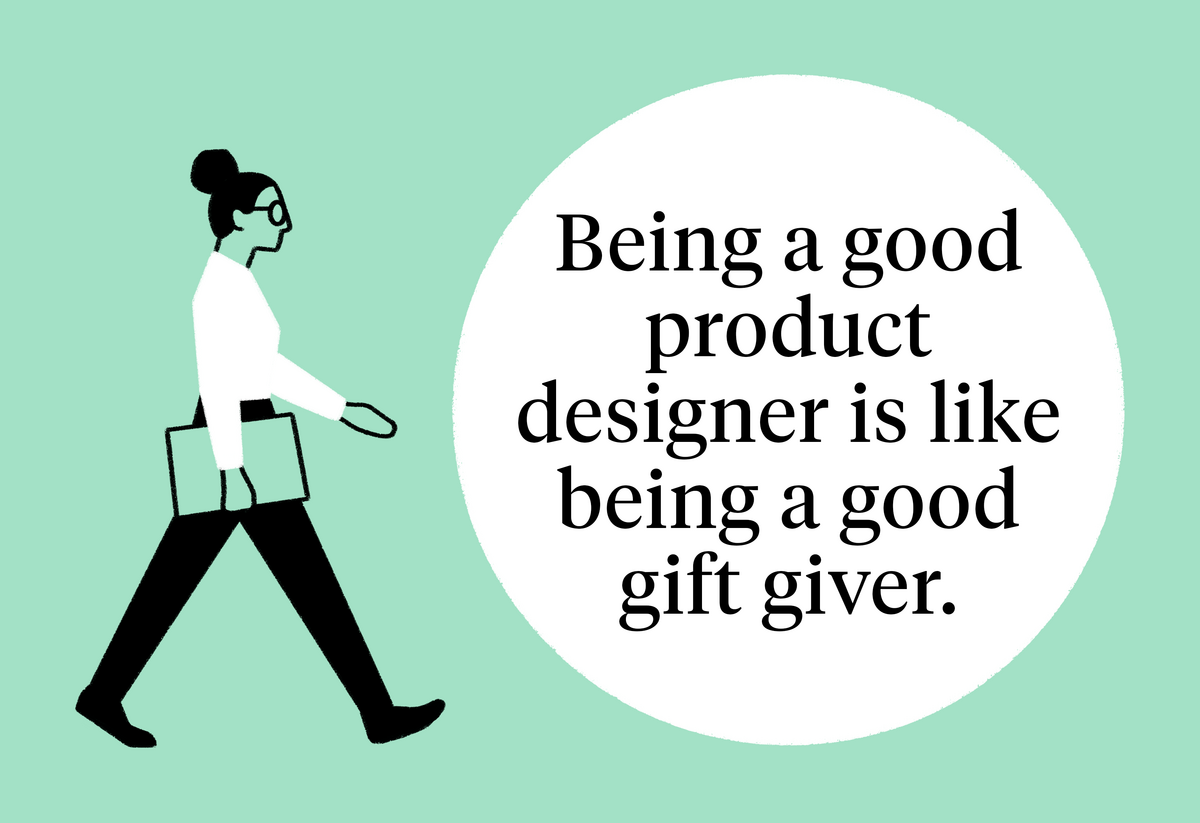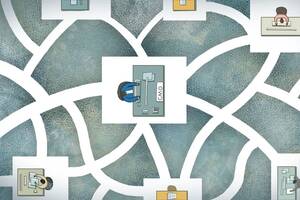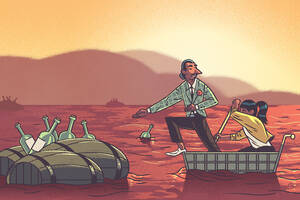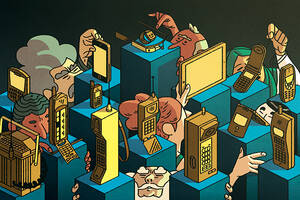Marketing Innovation Mar 5, 2024
Podcast: Need Product Inspiration? Meet Your Customer in the Wild.
On this episode of The Insightful Leader: a consumer anthropologist takes us behind the scenes as she interviews a “pet parent.”

You can learn a lot about a person by observing them in the right environment.
Back when she worked for a technology company, Gina Fong watched how its products were used in homes. On one such visit, she asked a customer to demonstrate how she would connect her camera to her printer.
“She had to go on the floor, crawl under her desk, get behind all these wires—and in the dark, under her desk—to attach this peripheral,” Fong said. “And those were the early days when we realized that we needed to create wireless printers for people in the home.”
Getting out from behind the data inspired that idea. The approach is called ethnographic research, and it seeks to understand consumers by observing them in their natural habitat. Usually, that’s their home.
On this episode of The Insightful Leader: Fong’s interview with a “pet parent” sheds light on the process.
Podcast Transcript
Laura PAVIN, NARRATOR: Early in her career, Gina Fong worked for a technology company. Among other products, they made printers.
Gina FONG: I remember going to people’s homes, and we would test how our products were actually working in households. And I’ll never forget the day that we went into a woman’s house. And she was talking about how she used her printer.
PAVIN: This woman was a bit elderly, and she enjoyed using a digital camera.
FONG: And we said, “how would you connect your digital camera to your printer?” And she had to go on the floor, crawl under her desk, get behind all these wires—and in the dark, under her desk—to attach this peripheral.
PAVIN: Now this should be easy. But it wasn’t.
FONG: I still have a very clear memory of this poor grandmother with us and the engineers in her house: She’s on her hands and knees, bum in the air, you know, trying to attach this device. And we all looked at each other. And we’re like, “there is a better way.” And those were the early days when we realized that we needed to create wireless printers for people in the home.
PAVIN, to FONG: [gasp] Ooooooooooooohhhhh!
FONG: That was also the day that we realized we needed to put all of the peripheral inputs at the front of a printer instead of in the back of the printer.
...
PAVIN, NARRATOR: It seems obvious now, right? It should be easy to connect your computer, phone, camera—what have you—to your printer. But, it took carefully studying a customer, like an anthropologist would, for the engineers to recognize this.
You’re listening to The Insightful Leader. I’m Laura Pavin. And today, we’re going to talk about this approach to understanding your customer: it’s called consumer ethnography. And it can lead to all sorts of insights you might miss in the data. That’s next.
...
PAVIN: Gina Fong is a clinical professor of marketing at Kellogg, and her specialty is consumer anthropology. In 2004, she was hired by a major pet-care company to study very devoted pet owners. The company wanted insight into their customers in order to be more relevant to them in terms of communication, products, and experiences. And, it wasn’t an easy assignment.
FONG: If you know anything about me, you will find out very quickly that I’m not really a pet person. And so the first time I had to interview people who are really into their pets, it was a stretch for me, it was like a mental stretch, to really dive into these people’s lives and understand how they could treat their pets the way they do, spend as much money as they do on their pets, and basically prioritize their pets above even some of the human members in their families. And I think my judgy title in my head was overcommitted owners.
PAVIN: But Fong knew that if she went into the process of interviewing pet owners with that judgey attitude, she wouldn’t learn as much. So she decided to lean into curiosity.
FONG: It was clear as I went from house to house to house the value of their pets, how much love and attention was being given from both the owner and the pet, and how much they improved these people’s lives. And I couldn’t deny that, I couldn’t dismiss that.
I think when you have empathy for someone else, it gives you the ability to want to surprise and delight somebody. If you sit in a world of judgment, you just think, “well, why should we bother?” or “this person is this way.” But when you get to the crux of who they are and why they’re motivated the way they are, and you really understand that, and you absorb it, and you internalize it, I don’t know if you have any choice but to figure out what you would do to surprise and delight them.
PAVIN: Fong’s insights into pet parents helped that company develop new products, new advertising, new packaging. But she says it also allowed her to develop a habitual curiosity about other people that she says has served her very well in her career. She now teaches students to do consumer ethnography: to study possible consumers to learn more about them. And she’s maintained her interest in “pet parents.”
But how does the consumer-ethnography process actually work? Fong allowed us to listen in on a recent interview she did with a pet parent, who is also a former student of hers, named Jyothi. Fong recorded the interview, and then shared the audio with us.
So we’re going to take a deep dive into Fong’s interview with Jyothi. Because, unlike other ways of studying customers, ethnography is very open-ended. There isn’t always a standard list of questions to ask or a survey to fill out. Instead, the ethnographer spends time with the consumer, in their home, and approaches that, not so much with a plan, but with curiosity and attentiveness to little details that might reveal big insights. Remember the lady with the printer from the beginning of the show? Those engineers had no idea what they were going to learn by spending time with her—their discoveries came from watching her.
After we listened to the interview, Fong came to our studio to talk about the experience: the moments that stood out for her, and why she asked certain questions when she did.
FONG: So it was probably the coldest day of the year here in Chicago. January, a Sunday morning, which might seem unusual, but when you’re an ethnographer, you have to visit consumers and people when it’s convenient for them. So we work some pretty odd hours. And we were on the west side of Chicago, and we went to visit someone that I know from the school—and she lived in what I would say is probably a townhome and in a really nice little neighborhood.
FONG: Jyothi, hello.
JYOTHI: Hi…
FONG: I’m so excited to do this interview—this ethnography with you. I’ve been wanting to do this with you ever since we met in class. I just want to give you the lay of the land…
PAVIN, to FONG: So, after you kind of orient Jyothi to how the time is going to go, you start out with Jyothi and her dog Gobi’s origin story.
JYOTHI: So I remember, my mom came to visit, and we were sitting on the couch, and I was like, “I just want a small dog that is obsessed with me.”
FONG: Can we pause there—what do you mean by “obsessed with me?”
JYOTHI: I … just a dog who loves me, and I love the dog. You know?
FONG: Sometimes people don’t even know their own origin story, or where they started. So getting them to introspect about that helps them realize how the pieces of their own story and their motivations actually come together.
JYOTHI: … And they brought him out, and he had a cone because he had just been neutered. And he was a small little guy. And he was so shy and nervous. And we learned that he had been adopted and returned…
PAVIN: So, you get a pretty long story—and a very sweet story—about how Jyothi and her husband, Damion, came to adopt Gobi, the dog. And it takes nearly a half hour. What were you noticing about the space, their home, in those early moments of the interview?
FONG: Jyothi is very fashionable, I think, and had a really great eye in terms of how she had the space developed, created, designed. But it was really apparent to me that this was also her dog’s space as well. And it was almost seamless. Like when we got into the house, and we were setting ourselves up, I knew immediately where the dog’s space was, like she didn’t even have to tell me. There was a beautiful, white, plush pillow in the most coveted part of the sectional couch. And true to nature, her dog climbed up on the couch, got on that pillow, and perched himself there almost the entire time.
JYOTHI: So I work over here, and so he has a little bed next to me, but he usually just hangs out in this space. And he can see because it’s all open. So if we’re in the kitchen, you know, he sits here and perches his head on the couch, and watches so he can see people, you know, coming in. He loves sunbathing. So this is a nice area.
FONG: If you were to move the pillow and sit there to watch television or to do something…
JYOTHI: He would just sit on me. He likes to be close to the action. That’s one thing is, he’s very go-with-the-flow. So if you do something, and he doesn’t love it, you’ll know but he won’t really hold it against you.
PAVIN: What were you trying to get out with the interjection about moving the pillow?
FONG: I think in that moment, what I was really trying to understand was, who was the boss of the house? Because there are things that happen in the house that you see, where he has very clear spaces in the house. And I don’t know if that’s really true of everyone that has a pet. I don’t have a pet. So this is really new territory for me, that you would have this beautifully-appointed, decorated home, and yet there are very clear spaces where it’s his space. So I was just wondering, who really rules the roost here?
FONG: One of the things I’m really curious about: when you are separated, how do you feel?
JYOTHI: Ugh, I feel awful. I think, I think about this more than Damion does. Like, “is Gobi OK? What is he doing?” Over the holidays, we were in Jamaica. So he was boarding, and of course I pick the place where there’s a camera so I can watch and see what he’s doing. So I’m like, “Oh, I wonder what Gobi’s doing?” And I’m logging on and checking. So when I’m away, I’m like, “aww … is he OK?” And he’s usually fine. But I think it’s just in my mind most of the time.
PAVIN: You spent a fair amount of time talking about her guilt and her discomfort. What were you hoping to understand there? Are you thinking at all of products or services that a company might develop in that moment?
FONG: I think there, what I wanted to understand were her emotions. What is it like to be separated from someone that’s so near and dear to you? But as an animal, what does it feel like to have these feelings of guilt that you’re leaving someone behind that you feel like maybe you should be taking with you? So really, what I was trying to do there was just explore more deeply the emotion she was feeling because I do think at some point, product development can be inspired by that.
PAVIN: Jyothi is very open with you about her dedication to Gobi. Some people might even find that level of dedication odd or even might be judgmental. Why do you think Jyothi trusts you enough to be so open?
FONG: Well, there are a couple things: First, I think when you’re doing this—you’re going into someone’s home—that you do have to have this connection with someone, even if you’re creating it on the fly. And if you’re curious, people will open up to you in ways that you never even imagined because you’re genuinely interested in their lives. I’m always shocked and pleasantly surprised how much people are willing to share with me, because I’m so curious about how they do things. And when you’re curious, too, you’re not judging, you genuinely want to know. And the way I define curiosity is “wonder without judgment.” And so you can stay in that space, “wonder without judgment,” I mean, people will go for it. They’ll share so much with you.
PAVIN: So we know she takes Gobi everywhere, she takes him to Chicago’s Christkindlmarket, that cozy, festive German Christmas market. And she buys him stuff there. And that got you digging into another dynamic that you seem to notice about who is really getting joy from Gobi’s gifts.
JYOTHI: One of the things we like to do is go to Christkindlmarket, and it’s outdoors. And we bring him in his parka. And it’s very festive. And so he’s with us when we shop for our ornaments. And so, you know, I don’t think he really cares. But we have fun. We’re like, “Oh, this is for Gobi. Gobi, this is for you.” So he’s part of the—he’s part of the experience. He’s part of the collection process. And then he could care less, really.
FONG: Yeah. Because it seemed like … but there are things that you do that really bring him joy. It’s an agreement like, the toys … like yeah, you buy them for him, you know, he likes them. He demonstrates he likes them. But this is different. Because there’s nothing that really he’s directly involved in here, whether it’s the choosing or the enjoying, or even the appreciating. So what is this about? I get the toys, I get the other theories. But...
JYOTHI: —It’s for me, it’s like a memory. Like, I look at the ornaments, and I say, “this is the first year we got Gobi. This is like his banana because this is his favorite toy. This is peanut butter, because he like licked a plate of peanut butter. He just, he’d never done that before, like, and so there’s these moments where, like, that, like, sticks in my mind. And so for me, it’s more of a … it’s a memory.
PAVIN: So dogs don’t need their own Christmas tree or Christmas ornaments. And they probably don’t even appreciate them. What do you think the value of those products is for the pet owners who buy them?
FONG: Yeah, it was so interesting, because there are many things that Gobi has in the house, that it’s clear, you know—we’ll use the word “chooses” loosely—that he chooses for himself, and that he really does enjoy. And then there are things that are in the house that are very clear, that he has no clue about. And one of those things is he has his own little Christmas tree next to all of his little toys in his basket. And then there’s the regular big Christmas tree. And on that tree are beautiful ornaments. And so Jyothi’s husband has some ornaments that are personal to him. She’s got some ornaments that are personal to her. And then Gobi’s got ornaments that are personal to him. Except, of course, he hasn’t chosen them. And the way that I saw that coming down, is that really, what they’re doing is they’re integrating him into the family: that if they have ornaments and he doesn’t have ornaments, then is he really a member of the family? They dressed him up in his little parka. And then they took him to the little market. And he was a part of the selection process. But I think we would all agree that he probably didn’t point to them and say, “I want that ornament.” So there’s something about this integration that’s really lovely, because it is for the humans.
PAVIN: Yeah, it really is. Up until this point, most of your questions have been really open-ended. But in this case, and this interaction that we just heard, you’re challenging her gently, like, “what’s going on here?” Are you aware that there’s sort of a natural progression in your interviews from more neutral, open-ended questions—you’re being very curious, like you were saying—to more challenging, analytical questions?
FONG: Yes, because what I’m doing in the beginning is really trying to understand her. And then, at some point, I have to switch gears to make sure that her understanding is really what I’m understanding. A lot of times I’ll do this in, like, “let’s play a game,” because I just want to see “is what they just said really true?” And again, it’s not meant to be a cross examination. But it’s to really understand the consistency of this, if I’m really understanding that what they just said is the way I’m interpreting it.
PAVIN, NARRATOR: Fong says at this point in the process, a consumer ethnographer will usually want to do two or three more interviews, and then present some of those insights to their client.
That might mean putting together a slideshow with some moments from the interview: In this case, maybe a photo of Gobi’s christmas tree with Gobi’s little ornaments.
And the presentation would also include some patterns and observations like: Many of the products Jyothi buys are about integrating Gobi into the family. Fong also says she avoids making specific recommendations about product design. She thinks the ethnographer’s role is to provide insight for the product designer.
PAVIN, to FONG: Do companies generally recognize the value of these kinds of consumer ethnographies, In your experience?
FONG: I think it depends. There are companies that are very aware of this method. And so they’re excited about it, and they use it often. And those are, of course, the companies that I work with. I think there are companies out there that have no idea this exists. And I wish they did. And then there are companies that do know about it, but maybe don’t do it quite the way I would hope—maybe they come in with a hypothesis, which is, they’ll say like, “here’s our hypothesis.” And then they want to do this kind of work to either prove or disprove the hypothesis. And I really think ethnographic research is about discovery: that you can’t go in to prove or disprove something. Because if you do that, as soon as you disprove it, or prove it, then you stop doing the research. And I really think this is about discovery. That’s why I don’t like to come in with a lot of biases, a lot of expectations. So if there are companies out there that are open to this research, I would just hope that they do it with a really open mind, and stay really curious, and do use that beginner’s mindset Because as soon as we start having those notions in our head, those biases, we start to look for those things. And then we might completely miss the consumer’s truth.
PAVIN: How do you think about the value of ethnography? Does it have an ROI?
FONG: When you understand someone else’s motivation, you can predict a lot about them. And that’s really what you want in business. You want the ability to predict because you don’t want to create things after the fact. You have to get out there ahead of the customer, ahead of your competition. If you’re a product designer, really what you should be thinking about is how to be a more insightful gift giver, where you’re staying ahead of the other person. That, when you give them this gift, they say, “how on earth did you know I would want this?” And that’s the feeling that we want our consumers to have. So that means that the product designer has to feel that way too. So it really means getting to know someone really deeply, because otherwise you end up giving them the gift of the generic: “oh, all pet owners love their dogs, so they probably want XYZ.” And if you really get to understand those nuances of the relationship—how they’re trying to integrate them into their households, in their lives, and become actual bonafide family members—that changes the landscape of what you could design.
...
PAVIN: Well, Gina Fong, thanks so much for sharing this interview and your work with us.
FONG: I could do this all day. You wanna pick another group of people? It’s just fun to get into other people’s lives.
[CREDITS]
PAVIN: Gina Fong is a Consumer Anthropologist at Fong Insight, and a clinical assistant professor of marketing at the Kellogg School. Jesse Dukes produced this episode, and Andrew Meriwether mixed it. The audio from the interview with Jyothi (and Gobi) was recorded by Vin Reed.
[ADDITIONAL CREDITS]
PAVIN: The Insightful Leader is produced and edited by Laura Pavin, Jessica Love, Susie Allen, Fred Schmalz, Maja Kos, and Blake Goble. Want more The Insightful Leader episodes? You can find us on iTunes, Spotify, or our website: insight.kellogg.northwestern.edu. We’ll be back in a couple weeks with another episode of The Insightful Leader Podcast.


